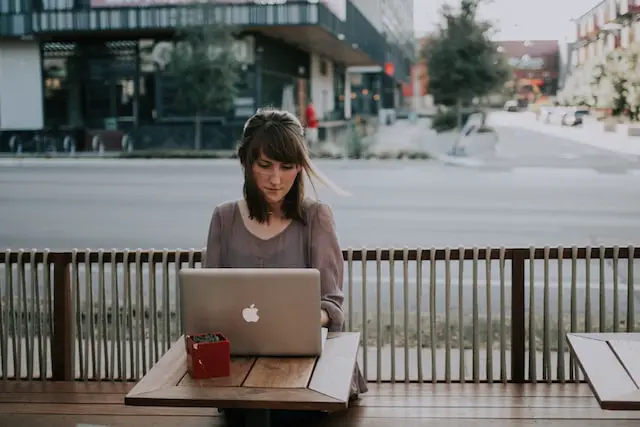I probably don’t have to tell you this, but one of the benefits of remote jobs is that you can work from anywhere. You’re not restricted to a cubicle or even an indoor office. If it’s a beautiful day, you can get some vitamin D while you pop open your laptop outdoors.
But if you haven’t prepared for this, you might be surprised at the challenges that crop up. You might not have considered the following necessities for optimal outdoor working spaces.
Electricity
What electronics do you need to work? If you’re settling down with a stack of papers, you might just need good lighting. But if you have a computer or mobile device, you’ll likely have to plug in at some point.
Set up outdoor working spaces in locations with covered outlets. If you’re working in a space adjacent to a home, you may need to run an extension cord from an indoor outlet to the outdoor working space. A power strip should come in handy if you use multiple devices simultaneously.
But some people don’t want to be tied to one location. Perhaps you’re more nomadic and want to spend some time at the park and other days at the beach. A portable power bank is small enough to slip into a backpack and powerful enough to charge your computer and mobile devices.
You’ll also need to consider your wi-fi access. A hot spot can work well if you’re mobile in areas with strong cell signal. But if you’re working outside your home, you might need to extend the signal from your router for the fastest service.
An Ergonomic Setup
Office chairs and desks are designed with the traditional worker in mind. But outdoor furniture is made for lounging. You might not be able to take notes when your paper is on a textured picnic table. Your laptop might not be stable on your wrought-iron patio table. Your Adirondack chair might not provide adequate lumbar support. And although it sounds like the ultimate symbol of remote work freedom, using your laptop from a hammock is downright uncomfortable.
It’s a good idea to invest in a chair that’s relatively firm and allows you to sit with good posture. This is especially true if you’re working at a computer. Similarly, a portable laptop desk may be ideal for your time outside, as would a floor-sitting desk, as both are very versatile.
A comfortable cushion will soften the pressure of long days on the job, but it’s not always the most convenient option–don’t leave it out overnight or you’ll be working on a soggy surface in the morning. Instead, an ergonomic seat cushion is small enough to tote around with you and support you for a full day.
If you’re establishing a dedicated workspace in one location, get a table with an adequate surface to write and use your laptop on. It should be smooth, level, and easy to clean. If you have a lounge-like outdoor workspace with coffee tables, consider adding taller side tables or trays to access your laptop better.
Finally, will you be working alone or with clients or colleagues? Think about in-person meetings that you’re likely to hold in the space. Make sure you have enough seating (and outlets, if necessary) for everyone.
An Attractive Backdrop
A good-looking background is essential if you conduct video calls. A rotting fence or garden cluttered with broken flower pots isn’t the most professional look. A busy urban backdrop might be distracting if you’re working from a coffee shop.
Set up a space that you can use when the visuals are important. A simple surface behind you, like the side of the house, is perfect. If you’re on a porch or pergola, drape some curtains to contain the space. Natural foliage or a lush lawn would be fine too.
Contain the Space
Noise and distractions can make it difficult to work outside. Establish your outdoor workspace in a spot that offers some privacy. You don’t want noise from traffic and passersby to interfere with your calls. You also don’t want to be talking about confidential work topics in certain public settings.
Settle into a space that is protected from visible and audible “noise” so that you can focus and work without impeding on anyone else. You could section off a corner of your front porch with potted plants or build a screen from pallets to corral a portion of your patio.
You might be tempted to make outdoor working spaces multi-functional. For example, you might love the idea of using your standing desk as a bar when you’re entertaining. This might not be the best idea. You don’t want to set your laptop down on barbecue sauce from Sunday’s picnic when you get to work on Monday. A dedicated space is almost always a better option, no matter how small it is.
Consider Glare
If you’ve ever had trouble seeing the display on your phone screen when snapping a photo on a sunny day, you know that it’s not always easy to work on electronics outdoors. The lighting can be harsh and create glare that makes it hard to work on documents or view your colleagues on Zoom.
Shade is almost always a necessity. A permanent outdoor structure like a pergola can provide shade. You can even throw up a camping-style canopy in a pinch.
But if you’re establishing an outdoor workspace that you’re returning to again and again, you might want to consider a high-quality umbrella or fabric shade. A retractable awning lets you adapt your workspace to the weather and is a valuable investment for long-term outdoor workspaces.
Shade structures with minimal texture or pattern are the best for reducing glare on screens. Avoid lattice and patterned fabric, which can make the problem worse. You can also buy anti-glare screen protectors to make it easier to see your screens in outdoor workspaces.
Prepare for the Weather
Outdoor working spaces aren’t in a static office environment. A strong gust of wind can scatter your papers or knock a glass of water onto your keyboard. A rainstorm can quickly damage your electronics. The sun can blind you as you squint at the computer screen.
Keep your outdoor workspace streamlined; only bring out what you need. If the weather turns sour, you can quickly scoop up your materials and dash indoors.
You might want to keep your essentials in a covered, rolling cart so that you can stash your things in inclement weather and keep them contained. Keep paperweights around to secure papers. Use covered beverage containers to avoid spills.
Learn how to adjust the brightness of your screens so that you can work with sunglasses on. Opt for adjustable seating so that you can move out of direct sunlight throughout the day.
Consider Climate Control
You can’t control the weather, but you can extend the use of outdoor working spaces throughout the seasons with climate control. A high-powered fan can keep you cool in the summer months when the shade is not enough. In a roofed structure, ceiling fans improve circulation.
Do you want to work in cooler weather? Patio heaters and blankets can keep you warm all winter. If you’re on the go, a portable heater or fan might be all you need to stay comfortable. Just make sure that you can tote it all inside if the weather changes.
Enjoy your outdoor working space and all of the benefits that it offers. Just don’t forget the bug spray!
Jared has worked remotely for 15 years in various marketing capacities, and has managed hundreds of marketing campaigns along the way. He has held freelance, agency, and in-house positions for companies large and small.


